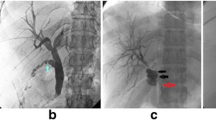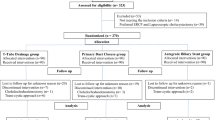Abstract
Background: Biliary fistulae may occur following surgical injury, abdominal trauma, or inadequate closure of a cystic duct stump. These leaks are most often managed by drainage of the associate biloma and either endoscopic sphincterotomy or placement of a biliary endoprosthesis to decrease the pressure gradient between the bile duct and the duodenum created by the muscular contraction of the ampullary sphincter. In a previous study, we demonstrated a statistically significant reduction in ductal pressures following stent placement as compared to sphincterotomy. The goal of this present study was to determine if reduction in ductal pressures correlates clinically with the resolution of biliary leaks in an animal model.
Methods: Fourteen mongrel dogs underwent laparotomy, cholecystectomy without closure of the cystic stump, and a lateral duodenotomy to identify the major papilla. The dogs were then randomized into three groups. Group I (n = 5) was a control group undergoing closure of the duodenotomy only. Group II (n = 4) underwent sphincterotomy. Group III (n = 5) underwent placement of a 7 Fr × 5 cm biliary endoprosthesis prior to duodenotomy closure. A drain was placed adjacent to the cystic duct stump in all groups. Drain output was recorded daily. The biliary leak was considered resolved when the output was <10 cc/day. Regardless of suspected fistula closure, the drains were not removed until 2 weeks postprocedure. Necropsy was performed to identify undrained intraperitoneal bile. Statistical analysis was performed using Student’s paired t test.
Results: All dogs had bile leaks identified on postoperative day 1. The number of days required for resolution of bile leak in group I (mean ± SEM) was 7.60 ± 0.87 days, as compared to 6.75 ± 0.80 days for group II and 2.60 ± 0.24 days for group III. There was no significant difference in the duration of bile leak between groups I and II (p= 0.445). Group III, however, had a significant reduction in the duration of biliary fistulae as compared to both groups I and II (p < 0.005). At autopsy, persistent bilomas were identified in 80% of group I, 25% of group II, and 0% of group III. None of the dogs showed evidence of dehisence of the duodenotomy closure site as a source of bile leak.
Conclusions: Biliary stenting significantly reduces the time to resolution of cystic duct leaks as compared to sphincterotomy in a canine model. The results obtained in this study support the use of biliary endoprostheses in the management of biliary leaks and fistulae.
Similar content being viewed by others
Author information
Authors and Affiliations
Additional information
Received: 19 March 1997/Accepted: 14 July 1997
Rights and permissions
About this article
Cite this article
Marks, J.M., Ponsky, J.L., Shillingstad, R.B. et al. Biliary stenting is more effective than sphincterotomy in the resolution of biliary leaks. Surg Endosc 12, 327–330 (1998). https://doi.org/10.1007/s004649900663
Published:
Issue Date:
DOI: https://doi.org/10.1007/s004649900663




